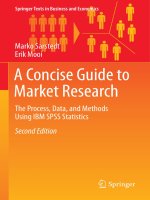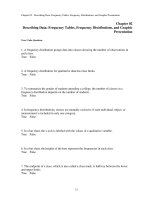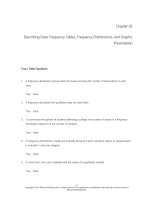Lecture Statistical techniques in business and economics - Chapter 6: Discrete probability distributions
Bạn đang xem bản rút gọn của tài liệu. Xem và tải ngay bản đầy đủ của tài liệu tại đây (1.45 MB, 39 trang )
6 1
Discrete Probability Distributions
Copyright © 2004 by The McGrawHill Companies, Inc. All rights reserved.
6 2
When you have completed this chapter, you will be able to:
1.
Define the terms probability distribution and
2.
Distinguish between discrete and
3.
Calculate the mean, variance, and standard deviation of
4.
Describe the characteristics and compute probabilities
random variable.
continuous random variables.
a discrete probability distribution.
using the Poisson probability distribution.
Copyright © 2004 by The McGrawHill Companies, Inc. All rights reserved.
Terminology
Random Variable
…is a numerical value determined by
…is a numerical value determined by
the outcome of an experiment.
the outcome of an experiment.
Probability Distribution
…is the listing of all possible outcomes
…is the listing of all possible outcomes
of an experiment
of an experiment
and the corresponding probability.
and the corresponding probability.
Copyright © 2004 by The McGrawHill Companies, Inc. All rights reserved.
6 3
Types of Probability Distributions
6 4
Discrete
Discrete
Under this distribution
Under this distribution
the random variable
random variable
the
has a
has a
countable number
countable number
of possible outcomes
of possible outcomes
Continuous
ontinuous
C
Under this distribution
Under this distribution
the random variable
random variable
the
has an
has an
infinite number
infinite number
of possible outcomes
of possible outcomes
Examples
Examples
Copyright © 2004 by The McGrawHill Companies, Inc. All rights reserved.
Types of Probability Distributions
6 5
Discrete
Discrete
Students in a class
Examples
Examples
Continuous
ontinuous
C
Distance driven by an
executive to get to work
Number of children
in a family
Mortgage Loan
Number of Mortgages
approved in a month
Copyright © 2004 by The McGrawHill Companies, Inc. All rights reserved.
The length of time of a
particular phone call
The length of
time of an
afternoon nap!
Distinguishing featuress
Distinguishing feature
6 6
of a
of a
Discrete Distribution:
Distribution:
Discrete
The sum of the probabilities of the various
outcomes is 1.00
The probability of a particular outcome
is between 0 and 1.00
The outcomes are mutually exclusive
Copyright © 2004 by The McGrawHill Companies, Inc. All rights reserved.
6 7
Consider a random experiment in which
Consider a random experiment in which
a coin is tossed three times
a coin is tossed three times
Let x be the number of
Heads
Let H represent the outcome of a
Let T represent the outcome of
Head
Tails
Determine the probability distribution
Determine the probability distribution
Copyright © 2004 by The McGrawHill Companies, Inc. All rights reserved.
Listing the possibilities
Listing the possibilities
6 8
Heads
Heads Heads
Heads
Heads
Tails
Heads
Tails
Heads
Tails
Heads
Heads
Heads
Tails
Tails
Tails
Heads
Tails
Tails
Tails
Heads
Tails
Tails
Tails
… the possible values of x
… the possible values of x
(number of heads) are 0,1,2,3.
(number of heads) are 0,1,2,3.
Copyright © 2004 by The McGrawHill Companies, Inc. All rights reserved.
6 9
Probability Distribution
Probability Distribution
Consider a
Consider a
random
random
experiment in
experiment in
which a coin is
which a coin is
tossed three times.
tossed three times.
Determine the
Determine the
probability
probability
distribution.
distribution.
What is the
probability of
tossing 2 heads in
3 flips?
P(x)
0
# of
Outcomes
1
1
3
3/8
2
3
3/8
3
1
1/8
8
8/8 = 1
x
Copyright © 2004 by The McGrawHill Companies, Inc. All rights reserved.
1/8
Mean of a Discrete
Mean of a Discrete
Probability Distribution
Probability Distribution
6 10
reports the central location of the data
is denoted by the Greek symbol , mu
is the longrun average value of
the random variable
also referred to as its expected value, E(X),
in a probability distribution
is a weighted average
Copyright © 2004 by The McGrawHill Companies, Inc. All rights reserved.
Mean of a Discrete
Mean of a Discrete
Probability Distribution
Probability Distribution
Formula
Formula
6 11
[xP( x))]
x
P(x)
xP(x)
1/8
0
1
3/8
3/8
2
3/8
6/8
3
1/8
3/8
8/8 = 1
12/8=1.5
Flip a coin three times 0
Let x be the
Let x be the
number of heads
number of heads
Copyright © 2004 by The McGrawHill Companies, Inc. All rights reserved.
Variance of a Discrete
of a Discrete
Variance
Probability Distribution
Probability Distribution
…measures the amount of spread
(variation) of a
distribution.
…denoted by the Greek
letter
2
(sigma squared).
…the standard deviation is
the square
root of
Copyright © 2004 by The McGrawHill Companies, Inc. All rights reserved.
2
6 12
Variance of a Discrete
of a Discrete
Variance
6 13
Probability Distribution
Probability Distribution
Flip a coin three times.
Flip a coin three times.
Let x be the number of heads
Let x be the number of heads
Formula
Formula
x
0
1
2
3
P(x)
1/8
3/8
3/8
1/8
8/8 = 1
[( x
2
xP(x) X
0
3/8
6/8
3/8
=1.5
Copyright © 2004 by The McGrawHill Companies, Inc. All rights reserved.
1.5
0.5
0.5
1.5
2
) P (( x)
x)]
2
(X )2 (X ) P(x)
2.25
0.25
0.25
2.25
.28125
.09375
.09375
.28125
0.75
6 14
Dan Desch, owner # of Painted
Dan Desch, owner
Weeks
P(x)
Houses
of College Painters,
x
of College Painters,
studied his records
studied his records
5
5/20 = 0.25
10
for the past
for the past
20 weeks
6
6/20 = 0.30
11
20 weeks
and reported
and reported
12
7
7/20 = 0.35
the following
the following
2
2/20 = 0.10
13
number
number
of houses painted
20
of houses painted
20/20 = 1.0
per week:
per week:
Determine the Probability distribution and its mean and variance.
Determine the Probability distribution and its mean and variance.
Copyright © 2004 by The McGrawHill Companies, Inc. All rights reserved.
Computing the
Computing the
Computing the
Computing the
6 15
[xP( x))]
Formula
Formula
# of Painted
Houses
P(x)
xP(x)
10
5/20 = 0.25
2.5
11
6/20 = 0.30
3.3
12
7/20 = 0.35
4.2
13
2/20 = 0.10
1.3
11.3
20/20 = 1.0
Copyright © 2004 by The McGrawHill Companies, Inc. All rights reserved.
Computing the
Computing the
2
Computing the
Computing the
Formula
Formula
x
2
[((xx
2
6 16
2
) P( x)
x)]
2
P(x) xP(x) (x )2 (x ) P(x)
22
1.69
(1011.3)
(1011.3)
10
0.25
2.5
11
0.30
3.3
0.09
.0270
12
0.35
4.2
0.49
.1715
13
0.10
1.3
11.3
2.89
.2890
0.91
0.91
1.0
Copyright © 2004 by The McGrawHill Companies, Inc. All rights reserved.
.4225
6 17
Binomial
Binomial
Probability
Probability
Distribution
Distribution
Copyright © 2004 by The McGrawHill Companies, Inc. All rights reserved.
TBernoulli Trial
erminology
…is a random experiment in which the
…is a random experiment in which the
number of possible outcomes
number of possible outcomes
is precisely two!
precisely two!
is
For Example…
Course Grade…
Heads
Tails
Right
Wrong
A
Copyright © 2004 by The McGrawHill Companies, Inc. All rights reserved.
B or C or D or…!
6 18
Binomial Probability
Binomial Probability
Distribution
Distribution
6 19
The experiment consists of n Bernoulli trials
The outcomes are classified into
one of two mutually exclusive
categories, …
such as success or failure
The probability of success
stays the same for each trial
The trials are independent
Interested in the number of successes
Copyright © 2004 by The McGrawHill Companies, Inc. All rights reserved.
Binomial Probability
Binomial Probability
Distribution
Distribution
6 20
Let…
n be the number of trials
x be the number of observed successes
p be the probability of success on each trial
Formula
Formula
P(x)
Copyright © 2004 by The McGrawHill Companies, Inc. All rights reserved.
x
(n x)
C
p
(
1
p
)
n x
6 21
The Department of Labour reports that
20% of the workforce
aged between 15 and 19 years is unemployed.
From a sample of 10 workers in this age group,
calculate the following probabilities:
Exactly three are unemployed
Exactly three are unemployed
At least three are unemployed
At least three are unemployed
None are unemployed
None are unemployed
At least one is unemployed
At least one is unemployed
Copyright © 2004 by The McGrawHill Companies, Inc. All rights reserved.
Calculations
Calculations
P( x)
x
(n x)
C
p
(
1
p
)
n x
6 22
DATA: 20% Unemployed & Sample of 10
Exactly three are unemployed
P ( 3)
3
103
C 3 (. 20 ) (1 . 20 )
(120)(.0080)(.2097)
.2013 or 20.13%
10
At least three are unemployed
P(x 3)
10
3
103
C3 (.20) (.80)
...
0
C (.20) (.80)
10 10
.2013 .0881 ... .000
.322 or 32.2%
Copyright © 2004 by The McGrawHill Companies, Inc. All rights reserved.
10
More…
More…
P( x)
x
(n x)
C
p
(
1
p
)
n x
6 23
DATA: 20% Unemployed & Sample of 10
None are unemployed
P ( 0)
100
0
C
(
1
.
20
)
10 0 (. 20 )
(1)(1) (.1074)
.1074 or 10.74%
At least one is unemployed
…same as “all the time”(100%)
“all the time”(100%) except when
except when
…same as
“none are unemployed”
“none are unemployed”
i.e. P (
=
1) 1 – P(0) = 1 .1074 = .8926 or 89.26%
89.26%
Copyright © 2004 by The McGrawHill Companies, Inc. All rights reserved.
Binomial Probability
Binomial Probability
Distribution
Distribution
Table 6.2
6 24
n = 10
Probability
X 0.05 0.10 0.20 0.30 0.40 0.50 0.60 0.70 0.80 0.90 0.95
0
1
2
3
4
5
6
7
8
9
0.599 0.349 0.107 0.028 0.006 0.001 0.000 0.000 0.000 0.000 0.000
0.315 0.387 0.268 0.121 0.040 0.010 0.002 0.000 0.000 0.000 0.000
0.075 0.194 0.302 0.233 0.121 0.044 0.011 0.000 0.000 0.000 0.000
0.010 0.057 0.201 0.267 0.215 0.117 0.042 0.009 0.001 0.000 0.000
0.001 0.011 0.088 0.200 0.251 0.205 0.111 0.037 0.006 0.000 0.000
0.000 0.001 0.026 0.103 0.201 0.246 0.201 0.103 0.026 0.001 0.000
0.000 0.000 0.006 0.037 0.111 0.205 0.251 0.200 0.088 0.011 0.001
0.000 0.000 0.001 0.009 0.042 0.117 0.215 0.267 0.201 0.057 0.010
0.000 0.001 0.000 0.001 0.011 0.044 0.121 0.233 0.302 0.194 0.075
0.000 0.000 0.000 0.000 0.002 0.010 0.040 0.121 0.268 0.387 0.315
10
0.000 0.001 0.000 0.000 0.000 0.001 0.006 0.028 0.107 0.349 0.599
Copyright © 2004 by The McGrawHill Companies, Inc. All rights reserved.
Binomial Probability
Binomial Probability
Distribution
Distribution
6 25
n = 10
From text Appendix A Probability
X
0.05 0.10 0.20 0.30 0.40 0.50 0.60 0.70 0.80 0.90 0.95
0
1
2
3
4
0.599 0.349 0.107 0.028 0.006 0.001 0.000 0.000 0.000 0.000 0.000
0.315 0.387 0.268 0.121
Where represents the
0.040 0.010 0.002 0.000 0.000 0.000 0.000
0.075 0.194 0.302 0.233 0.121 0.044 0.011 0.000 0.000 0.000 0.000
Represents the
0.010 0.057 0.201 0.267 0.215 0.117
0.042 0.009 0.001 0.000 0.000
0.001 0.011 0.088 0.200 0.251 0.205 0.111 0.037 0.006 0.000 0.000
0.000 0.001 0.026 0.103 0.201 0.246 0.201 0.103 0.026 0.001 0.000
0.000 0.000 0.006 0.037 0.111 0.205 0.251 0.200 0.088 0.011 0.001
0.000 0.000 0.001 0.009 0.042 0.117 0.215 0.267 0.201 0.057 0.010
0.000 0.001 0.000 0.001 0.011 0.044
0.121 0.233 0.302 0.194
0.075
Represents the ‘ PROBABILITY’
when
0.000 0.000 0.000 0.000 0.002 0.010 0.040 0.121 0.268 0.387 0.315
5
6
7
8
9
10
X
‘Number Unemployed’
‘Probability’
Explanations
Explanations
n = 10
0.000 0.001 0.000 0.000 0.000 0.001 0.006 0.028 0.107 0.349
0.599
Using Appendix A
Copyright © 2004 by The McGrawHill Companies, Inc. All rights reserved.
Using Appendix A









